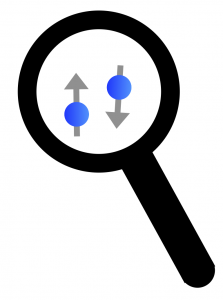- Home
- Institut Néel
- Research teams
- Technical Groups & Services
- Work at the Institut
- Partnerships
 Next Quantum Material Seminar/LANEF:
Next Quantum Material Seminar/LANEF:
Thursday, May 11th 2023 at 2:00 pm
Andreas Honecker (LPTM, CY Cergy Paris Université)
“ Thermodynamic properties of highly frustrated quantum antiferromagnets”
To access this seminar:
Institut Néel CNRS, Building K, Room Rémy Lemaire (K223)
Abstract: Reliable computation of the low-temperature thermodynamic properties of highly frustrated quantum magnets is important for experiments, but also a considerable challenge since, e.g., conventional Quantum-Monte-Carlo (QMC) simulations suffer from a severe minus sign problem. In some cases, progress can be made by a suitable choice of computational basis. For example, in certain cases, QMC simulations in the dimer basis reduce or eliminate the sign problem sufficiently to be able to obtain accurate results for thermodynamic quantities. In the following, we discuss some examples and applications.
SrCu2(BO3)2 is famous for its rich physical properties and as a realization of the two-dimensional spin-1/2 Shastry-Sutherland model. In the latter model, an orthogonal arrangement of dimers gives rise both to geometric frustration and an exact dimer ground state. Beyond this dimer phase at small inter-dimer coupling, the ground-state phase diagram contains two further phases: an antiferromagnetic phase at large interdimer couplings and an intermediate plaquette phase. Application of pressure to SrCu2(BO3)2 allows to tune the ratio of the coupling constants across the phase transition between the dimer and plaquette phases [1]. High-precision specific-heat measurements demonstrate that the pressure-temperature phase diagram has a first-order transition line that separates phases with different local magnetic energy densities, and that terminates at an Ising critical point. These experimental findings are in agreement with numerical results for the Shastry-Sutherland model and reminiscent of the phase diagram of water.
Another example is the spin-1/2 Heisenberg antiferromagnet on the diamond-decorated square lattice which exhibits a rich ground-state phase diagram in a magnetic field [2]. Here, sign-free QMC simulations reveal again first-order lines [2,3]. Furthermore, a “dimer-tetramer” phase appears in this model at low magnetic fields. This phase maps to a classical dimer model on the square lattice, which implies a macroscopic ground-state degeneracy that survives in a magnetic field. We discuss the consequences of this degeneracy for the thermodynamic and magnetocaloric properties of the model.
[1] J. Larrea Jiménez, S.P.G. Crone, E. Fogh, M.E. Zayed, R. Lortz, E. Pomjakushina, K. Conder, A.M. Läuchli, L. Weber, S. Wessel, A. Honecker, B. Normand, Ch. Rüegg, P. Corboz, H. M. Rønnow, A Quantum Magnetic Analogue to the Critical Point of Water, Nature 592 (2021) 370-375
[2] N. Caci, K. Karl’ová, T. Verkholyak, J. Strečka, S. Wessel, A. Honecker, Phases of the Spin-1/2 Heisenberg Antiferromagnet on the Diamond-Decorated Square Lattice in a Magnetic Field, Phys. Rev. B 107 (2023) 115143
[3] J. Strečka, K. Karl’ová,T. Verkholyak, N. Caci, S. Wessel, A. Honecker, Thermal First-Order Phase Transitions, Ising Critical Points, and Reentrance in the Ising-Heisenberg Model on the Diamond-Decorated Square Lattice in a Magnetic Field, Phys. Rev. B 107 (2023) 134402
The organizers:
Elsa Lhotel (elsa.lhotel@neel.cnrs.fr)
Florence Levy-Bertrand (florence.levy-bertrand@neel.cnrs.fr)
